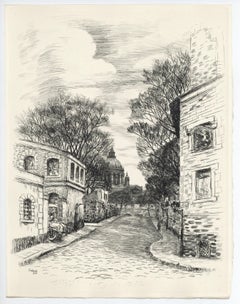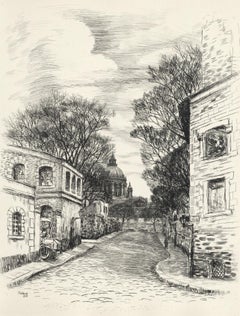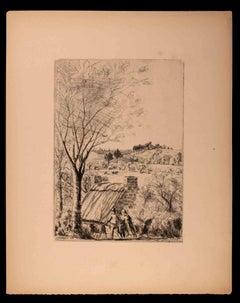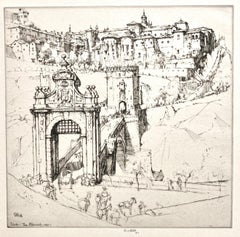Jean Frélaut Art
to
1
4
Overall Width
to
Overall Height
to
1
3
2
1
3
4
3
2
2
1
1
1
1
4
4
7,820
5,167
2,504
1,501
2
1
Artist: Jean Frélaut
"Sante aux Gobelins" original etching
By Jean Frélaut
Located in Henderson, NV
Medium: original etching. This impression on Canson et Montgolfier wove paper was printed in 1937 in an edition of 500 for the "Paris 1937" portfolio. Printed at the atelier of Jean-...
Category
1930s Jean Frélaut Art
Materials
Etching
De la Sante aux Gobelins, A La gloire à Paris, Jean Frélaut
By Jean Frélaut
Located in Auburn Hills, MI
Etching on vélin Canson et Montgolfier paper. Unsigned and unnumbered, as issued. Good condition. Published by L'Imprimerie Daragnès, Paris; printed by Jean Gabriel Daragnès, Paris, ...
Category
1930s Modern Jean Frélaut Art
Materials
Etching
Countryside - Original Etching by Jean Frélaut - 19th Century
By Jean Frélaut
Located in Roma, IT
Countryside is an Original Etching realized by Jean Frélaut (1879-1954).
The artwork is in good condition included a white cardboard passpartout (50x32 cm).
No signature.
Jean Fré...
Category
19th Century Modern Jean Frélaut Art
Materials
Etching
Superlative Sunrise - Original etching, 1943
By Jean Frélaut
Located in Paris, IDF
Jean FRELAUT
Superlative Sunrise
Original etching
Printed signature in the plate
On Arches vellum 30 x 25 cm (c. 12 x 10 inch)
Printed in Haasen workshop in 1943
Excellent condition
Category
1940s Modern Jean Frélaut Art
Materials
Etching
Related Items
Untitled (Fantastic Scene)
By Michael Bowen
Located in San Francisco, CA
This artwork "Untitled, Fantastic Scene" c.1975 is an original color etching with aquatint on wove paper by American surrealist artist Michael Bowen, 1937-2009. It is hand signed in pencil by the artist. The plate mark (image) size is 14.85 x 18 inches, sheet size is 21.5 x 26 inches. It is in excellent condition, has never been framed.
About the subject:
Nowhere is the intertwining of metaphysical, biographic and social narratives more evident than in the Café Life series painted in the 1980’s. Though the “series” was done in the 80’s, the pieces really revive the spirit of the Beat café scene, which began in the mid-1950’s and which was so instrumental to the particular spiritual and social vibe of the counter culture. And his Café Life observations continue over his artist life with scenes, such as the ones here, from Los Angles, Bolinas, Mexico and Italy.
About the artist:
Michael Bowen (December 8, 1937 – March 7, 2009) was an American fine artist known as one of the co-founders of the late 20th and 21st century Visionary art movements. His works include paintings on canvas and paper, 92 intaglio etchings based on Jungian psychology, assemblage, bronze sculpture, collage, and handmade art books. An icon of the American Beat Generation and the 1960s counterculture, Bowen is also known for his role in inspiring and organizing the first Human Be-In in San Francisco. Chronicled in books and periodicals reflecting on the turbulent 1960s, Bowen's historical impact on both the literary and visual art worlds is well documented. He remains influential among avant-garde art circles around the world. He started his art career at age 17, when he joined the American installation artist Ed Kienholz in his Los Angeles studio. There he met and joined with other influential Beat Generation artists including Wallace Berman, John Altoon, and Dennis Hopper. Bowen participated in the construction of the Ferus Gallery and Now Gallery created by Ed Kienholz and curated by Walter Hopps. Bowen attended the Chouinard Art Institute for several years during his formative artistic experiences in Los Angeles. In the late 50s and early 60s, Bowen continued his spiritual training and research. He investigated and practiced a variety of occult topics, Eastern philosophies, and mysticism, and his artwork reflected these themes. Bowen is often referred to as a mystic artist. As a lifelong student of the Bhagavad-Gita, Bowen's entire career has emulated the spiritual warrior archetype of Arjuna, fighting for the Bill of Rights of the United States Constitution. Michael Bowen moved to San Francisco in the late 1950s, and along with fellow artist comrades Arthur Monroe...
Category
Late 20th Century Surrealist Jean Frélaut Art
Materials
Etching, Aquatint
Ernest David Roth, Toledo, The Approach
By Ernest David Roth
Located in New York, NY
Working in the tradition of the Etching Revival, Ernest David Roth made this amazingly conceived and detailed study of the entrance to the Spanish ci...
Category
Early 20th Century American Modern Jean Frélaut Art
Materials
Etching
Silent Snow (Poetical imagery and Christmas memories in New England)
By Mary Teichman
Located in New Orleans, LA
This image is from an exclusive edition published by Stone + Press in 1994 in an edition of 100. This impression is #98. It brings to mind the Robert Frost poem, Stopping by Woods on a Snowy Evening.
The woods are lovely, dark and deep,
But I have promises to keep,
And miles to go before I sleep,
And miles to go before I sleep.
Mary Teichman...
Category
1990s American Modern Jean Frélaut Art
Materials
Etching
Margit Smiles
By Alex Katz
Located in New York, NY
signed and numbered lower image
edition 7/40
Catalogue raisonné 00269
Internationally recognized painter and printmaker Alex Katz was born in 1927 in Brooklyn, New York. Over a thir...
Category
1990s Contemporary Jean Frélaut Art
Materials
Aquatint
Paul Klee Etching "Die Szene mit der Laufenden"
By (after) Paul Klee
Located in Berlin, DE
Helio-etching on hand-made paper, 1925 by Paul Klee. Signatur is printed, lower right: Klee
From portfolio Paul Klee, Handzeichnungen 1921-1930; Here no 28
Image: 5.63 x 7.48 in ( 14...
Category
Early 20th Century Expressionist Jean Frélaut Art
Materials
Etching
IV unique Printers Proof Color field geometric abstraction pencil signed pochoir
By Larry Zox
Located in New York, NY
Larry Zox
Untitled IV, ca. 1979
Pochoir on Arches Paper with Deckled Edges. Hand signed and annotated Printers Proof in pencil on the lower front.
28 1/2 × 22 1/2 inches
Unframed
This beautiful Larry Zox pochoir on Arches paper with deckled edges a unique Printers Proofs - signed by the artist in pencil on the lower front.
We do not know the size of the regular edition, or whether there is a regular edition, but this is indeed a unique PP.
LARRY ZOX BiIOGRAPHY
A painter who played an essential role in the Color Field discourse of the 1960s and 1970s, Larry Zox is best known for his intensely and brilliantly colored geometric abstractions, which question and violate symmetry. Zox stated in 1965: “Being contrary is the only way I can get at anything.” To Zox, this position was not necessarily arbitrary, but instead meant “responding to something in an examination of it [such as] using a mechanical format with X number of possibilities.”[2] What he sought was to “get at the specific character and quality of each painting in and for itself,” as James Monte stated in his introductory essay in the catalogue for Zox’s 1973–74 solo exhibition at the Whitney Museum of American Art.[3] Zox also at times used a freer, more intuitive method, while maintaining coloristic autonomy, which became increasingly important to him in his later career.
Zox began to receive attention in the 1960s, when he was included in several groundbreaking exhibitions of Color Field and Minimalist art, including Shape and Structure (1965), organized by Henry Geldzahler and Frank Stella for Tibor de Nagy, New York, and Systemic Painting (1966), organized by Lawrence Alloway for the Guggenheim Museum. In 1973–74, the Whitney’s solo exhibition of Zox’s work gave recognition to his significance in the art scene of the preceding decade. In the following year, he was represented in the inaugural exhibition of the Hirshhorn Museum, which acquired fourteen of his works.
Zox was born in Des Moines, Iowa. He attended the University of Oklahoma and Drake University, and then studied under George Grosz at the Des Moines Art Center. In 1958, Zox moved to New York, joining the downtown art scene. His studio on 20th Street became a gathering place for artists, jazz musicians, bikers, and boxers. He occasionally sparred with visiting fighters. He later established a studio in East Hampton, a former black smithy used previously by Jackson Pollock.
Zox’s earliest works were collages consisting of pieces of painted paper stapled onto sheets of plywood. He then produced paintings that were illusions of collages, including both torn- and trued-edged forms, to which he added a wide range of strong hues that created ambiguous surfaces. Next, he omitted the collage aspect of his work and applied flat color areas to create more complete statements of pure color and shape. He then replaced these torn and expressive edges with clean and impersonal lines that would define his work for the next decade.
From 1962 to 1965, he produced his Rotation series, at first creating plywood and Plexiglas reliefs, which turned squares into dynamic polygons. He used these shapes in his paintings as well, employing white as a foil between colors to produce negative spaces that suggest that the colored shapes had only been cut out and laid down instead of painted. The New York Times noted in 1964: “The artist is hip, cool, adventurous, not content to stay with the mere exercise of sensibility that one sees in smaller works.”[4]
In 1965, he began the Scissors Jack series, in which he arranged opposing triangular shapes with inverted Vs of bare canvas at their centers that threaten to split their compositions apart. In several works from this series, Zox was inspired by ancient Chinese water vessels. With a mathematical precision and a poetic license, Zox flattened the three dimensional object onto graph paper, and later translated his interpretation of vessel’s lines onto canvas with masking tape, forming the structure of the painting.
The Diamond Cut and Diamond Drill paintings...
Category
1970s Color-Field Jean Frélaut Art
Materials
Etching, Pencil, Monoprint
Altra Veduta presa sotto... - Etching by Luigi Rossini - 1825
By Luigi Rossini
Located in Roma, IT
Altra Veduta presa sotto il grand' Arco dell'interno dell'Emissario di Albano is an original etching belonging to the series "Le Antichità di contorni di Roma” (…)".
Beautiful proof...
Category
1820s Modern Jean Frélaut Art
Materials
Etching
H 27.37 in W 20.08 in D 0.04 in
S. L Margolies, Silent Symphony
Located in New York, NY
S. L Margolies (Samuel L.) made dynamic urban views and calm country scenes. This peaceful subject, with snow-covered hills and tidy cabin, Silent Symphony, 1946, marks an end to the...
Category
Mid-20th Century American Modern Jean Frélaut Art
Materials
Etching
Veduta di Tivoli mista d'Antico, e moderno (...) - Etching by L. Rossini - 1824
By Luigi Rossini
Located in Roma, IT
Veduta di Tivoli mista d'Antico, e moderno (...)
From the collection: “Le antichità de' contorni di Roma ossia le più famose città del Lazio. Tivoli, Albano...
Category
1820s Modern Jean Frélaut Art
Materials
Etching
H 19.93 in W 27.09 in D 0.04 in
The Biggest of All; Telephone and Telegraph Building.
By Joseph Pennell
Located in Storrs, CT
The Biggest of All; Telephone and Telegraph Building. 1925. Etching. Wuerth 853. 9 7/8 x 11 7/8 (sheet 11 1/2 x 17 1/8). Edition probably 35. An atmospheric impression with plate tone, printed on antique laid paper...
Category
Early 20th Century American Modern Jean Frélaut Art
Materials
Drypoint, Etching
H 9.88 in W 7.88 in D 0.5 in
Paul Klee Etching "Möchten sollen"
By Paul Klee
Located in Berlin, DE
Helio-etching on hand-made paper, 1927 by Paul Klee. From portfolio "Paul Klee, Handzeichnungen 1921-1930" Here no 41
Measurements: Image: 5.51 x 7.48 in ( 14 x 19 cm ), Framed: 13.4...
Category
Early 20th Century Expressionist Jean Frélaut Art
Materials
Etching
The Gargoyle and His Quarry
By John Taylor Arms
Located in Storrs, CT
The Gargoyle and His Quarry, Notre Dame. 1920. Etching.Fletcher 90. 7 1/8 x 5 1/4 (sheet 10 1/2 x 9 1/16). Gargoyle series #1. Edition 75. A rich impression printed on 'FJHead&Co' c...
Category
1920s American Modern Jean Frélaut Art
Materials
Drypoint, Etching
Jean Frélaut art for sale on 1stDibs.
Find a wide variety of authentic Jean Frélaut art available for sale on 1stDibs. You can also browse by medium to find art by Jean Frélaut in etching and more. Much of the original work by this artist or collective was created during the 1940s and is mostly associated with the modern style. Not every interior allows for large Jean Frélaut art, so small editions measuring 9 inches across are available. Customers who are interested in this artist might also find the work of Pierre Quentin Chedel, Paulette Humbert, and Eugene Corneau. Jean Frélaut art prices can differ depending upon medium, time period and other attributes. On 1stDibs, the price for these items starts at $216 and tops out at $264, while the average work can sell for $240.



